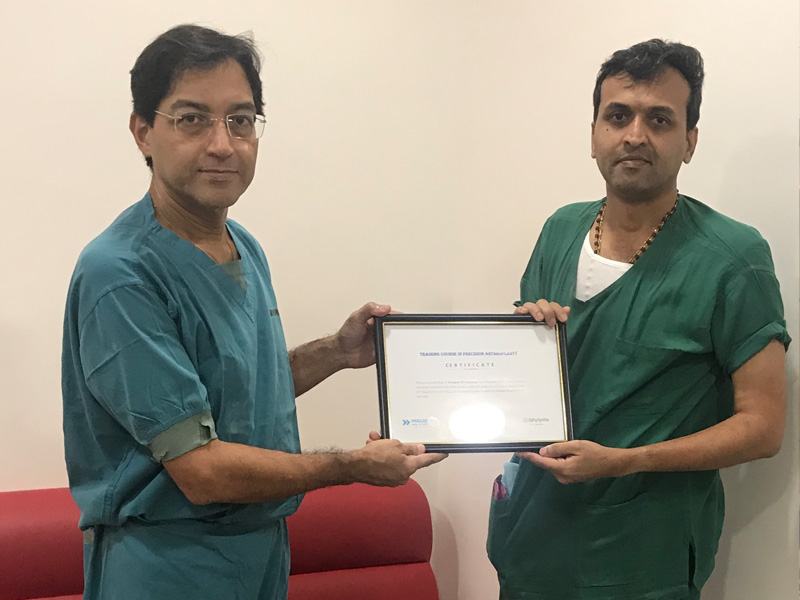Trained Orthopedic robotic navigated knee replacement surgery - Dr Deepak inamdar in Bengaluru having being trained in robotic knee replacement surgery with Dr.Anoop Jhurani , FORTIS HOSPITAL , Jaipur and with dr arun mullaji breach candy hospital mumbai for computer navigated knee replacement training , he has also been trained in Singapore general hospital ,Singapore for computer assisted navigation knee replacements for performing robotic stitch less knee replacement surgeries in jayanagar , Bengaluru .
The NAVIO robotic Surgical System is a tool your surgeon uses to correctly size and position the total knee implant with computer and robotic assistance. Computer assistance is used to collect the unique shape and motion of your knee to virtually plan the procedure. Robotic assistance is used to accurately perform the procedure. The extra layer of planning and precision provided by the NAVIO system aims to ensure the procedure is performed exactly as your surgeon intends. The NAVIO system does not perform the procedure; rather it assists your surgeon by providing accuracy and precision3 – crucial to the success of the surgery


The NAVIO robotic Surgical System is designed to offer accuracy, value and freedom at the cutting edge of robotics-assisted surgery; helping surgeons improve outcomes and patient satisfaction in total and partial knee arthroplasty.
NAVIO Handheld Robotics improves alignment, stability and proprioception, which may help implant survivorship factors commonly associated with patient satisfaction.
Giving patients the confidence to get the surgery they need.
You will first be placed under anesthesia to relax your body for surgery and block pain. The correct form of anesthesia will be discussed and determined prior to surgery with your surgeon and anesthesiologist. Your surgeon will then make an incision that extends several inches above the knee cap to several inches below the knee cap. Using the NAVIO™ robotic system system, special trackers are secured to both the thigh bone (femur) and shin bone (tibia) with four small surgical pins placed through tiny incisions in the skin. These trackers are crucial to the precision of the system as they provide a constant reference point to the surgeon throughout the procedure. Using computer assistance, the unique shape and motion of your knee are collected by the surgeon. This allows for a three-dimensional model of your knee to be generated and used by the surgeon to plan the procedure. Proper implant size and position will be determined at this time.


Once your surgeon virtually determines the correct implant size and positioning, a handheld robotics-assisted tool (the NAVIO™ handpiece) is used to accurately position bone removal cut guides. These cut guides enable the surgeon to use a surgical saw to remove your damaged knee bone, making room for the implant. The extra layer of precision provided by the NAVIO system is designed to enable accurate cut guide placement. The NAVIO robotic system does not perform the procedure; rather it assists your surgeon by providing accuracy and precision crucial to the success of the surgery. Once the implant is in the final position, the incision is thoroughly cleaned and closed, completing the procedure.

